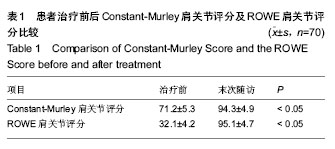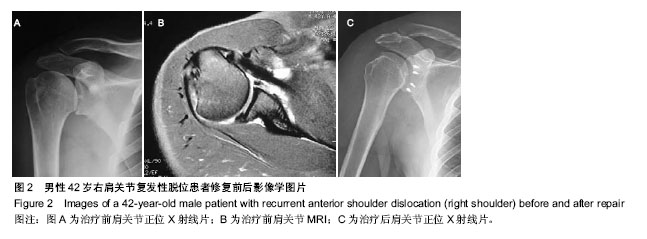| [1] Shields E, Mirabelli M, Amsdell S, et al. Functional and imaging outcomes of arthroscopic simultaneous rotator cuff repair and bankart repair after shoulder dislocations. Am J Sports Med. 2014;42(11):2614-2620.
[2] 黄华杨,郑小飞,张余,等.关节镜下非打结型缝合锚钉修补Bankart损伤治疗复发陛肩关节前脱位[J].中华骨科杂志,2008, 28(11):912-916.
[3] 姜春岩,冯华,洪雷,等.复发性肩关节前脱位的关节镜治疗[J].中华骨科杂志,2005,25(6):321-325.
[4] 闫辉,崔国庆,王健全,等.关节镜下Bankart修复术治疗肩关节复发性前脱位:手术效果及复发危险因素分析[J].中华外科杂志, 2011,49(7):597-602.
[5] 刘玉杰,蔡谞,王志刚,等.关节镜下可吸收铆钉固定修复Bankart损伤[J]. 中华外科杂志,2005, 43(16):1072-1074.
[6] Aslani H,Zafarani Z, Ebrahimpour A, et al. Early clinical results of arthroscopic remplissage in patients with anterior shoulder instability with engaging hill-sachs lesion in iran. Arch Bone Jt Surg. 2014;2(1):43-46.
[7] Horst K, Von Harten R, Weber C, et al. Assessment of coincidence and defect sizes in Bankart and Hill-Sachs lesions after anterior shoulder dislocation: a radiological study. Br J Radiol. 2014;87(1034):20130673.
[8] Di Giacomo G, De Vita A, Costantini A, et al. Management of humeral head deficiencies and glenoid track. Curr Rev Musculoskelet Med. 2014; 7(1):6-11.
[9] Argintar E,Heckmann N, Wang L,et al.The biomechanical effect of shoulder remplissage combined with Bankart repair for the treatment of engaging Hill-Sachs lesions. Knee Surg Sports Traumatol Arthrosc. 2014.
[10] Rhee YG, Cho NS, Yoo JH, et al. Filling Index Score of Remplissage (FISOR):a useful measurement tool to evaluate structural outcome afterremplissage. J Shoulder Elbow Surg. 2014. pii S1058-2746(14)00497-2.
[11] Longo UG, Loppini M,Rizzello G,et al.Remplissage, humeral osteochondral grafts, weber osteotomy, and shoulder arthroplasty for the management of humeral bone defects in shoulder instability: systematic review and quantitative synthesis of the literature. Arthroscopy. 2014;30(12):1650-1666.
[12] McCabe MP,Weinberg D, Field LD,et al.Primary versus revision arthroscopic reconstruction with remplissage for shoulder instability with moderate bone loss. Arthroscopy. 2014;30(4):444-450.
[13] Omi R, Hooke AW,Zhao KD,et al.The effect of the remplissage procedure on shoulder range of motion: a cadaveric study. Arthroscopy. 2014;30(2):178-187.
[14] Flinkkilä T, Sirniö K.Open Latarjet procedure for failed arthroscopic Bankart repair. Orthop Traumatol Surg Res. 2015;101(1):35-38.
[15] Fedorka CJ, Mulcahey MK.Recurrent anterior shoulder instability: a review of the Latarjet procedure and its postoperative rehabilitation. Phys Sportsmed. 2015;19:1-7.
[16] Balestro JC, Young A, Maccioni C,et al.Graft osteolysis and recurrent instabilityafter the Latarjet procedure performed with bioabsorbable screw fixation. J Shoulder Elbow Surg. 2014. pii: S1058-2746(14)00425-X.
[17] Abdelhady A, Abouelsoud M, Eid M. Latarjet procedure in patients with multiple recurrent anterior shoulder dislocation and generalized ligamentous laxity. Eur J Orthop Surg Traumatol. 2014.
[18] Maiotti M, Massoni C.Arthroscopic augmentation with subscapularis tendon in anterior shoulder instability with capsulolabral deficiency. Arthrosc Tech. 2013;2(3):e303-310.
[19] Savoie FH 3rd, O'Brien MJ. Anterior instability in the throwing shoulder. Sports Med Arthrosc. 2014;22(2):117-119.
[20] Ozorak M, Kokavec M, Svec A. Arthroscopic management of anterior instability of the shoulder. Ortop Traumatol Rehabil. 2014;16(2):111-118.
[21] Bessière C, Trojani C, Carles M, et al.The open latarjet procedure is more reliable in terms of shoulder stability than arthroscopic bankart repair. Clin Orthop Relat Res. 2014; 472(8):2345-2351.
[22] Shibata H, Gotoh M, Mitsui Y,et al.Risk factors for shoulder re-dislocation after arthroscopic Bankart repair. J Orthop Surg Res. 2014;9(1):53.
[23] Neoral P, Holibka R, Kalina R, et al.Arthroscopic stabilisation of the shoulder. Risk factors for its failure. Acta Chir Orthop Traumatol Cech. 2014;81(1):51-56.
[24] Provencher MT, Frank RM, Leclere LE, et al. The Hill-Sachs lesion: diagnosis, classification, and management. J Am Acad Orthop Surg. 2012;20(4):242-252.
[25] Boileau P, Thélu CÉ, Mercier N,et al.bristow-latarjet combined with bankart repair restores shoulder stability in patients with glenoid bone loss. Clin Orthop Relat Res. 2014;472(8): 2413-2424.
[26] Agneskirchner JD, Lafosse L.Transfer of the coracoid process in recurrent anterior instability of the shoulder joint. The arthroscopic Latarjet procedure. Oper Orthop Traumatol. 2014; 26(3):296-306.
[27] Buza JA 3rd, Iyengar JJ, Anakwenze OA,et al.Arthroscopic Hill-Sachs remplissage: a systematic review. J Bone Joint Surg Am. 2014;96(7):549-555.
[28] Ko SH,Shin SM,Jo BG.Outcomes of minimally 1 year follow-up for the arthroscopic Remplissage technique with Hill-Sachs lesion. J Orthop. 2013;10(1):41-45.
[29] Garcia GH,Park MJ,Baldwin K,et al.Comparison of arthroscopic osteochondral substitute grafting and remplissage for engaging Hill-Sachs lesions. Orthopedics. 2013;36(1):e38-43.
[30] Leroux T, Bhatti A,Khoshbin A,et al.Combined arthroscopic Bankart repair and remplissage for recurrent shoulder instability. Arthroscopy. 2013;29(10):1693-1701.
[31] Wolf EM,Arianjam A. Hill-Sachs remplissage, an arthroscopic solution for the engaging Hill-Sachs lesion: 2- to 10-year follow-up and incidence of recurrence. J Shoulder Elbow Surg. 2014;23(6):814-820.
[32] Trivedi S, Pomerantz ML, Gross D, et al.Shoulder instability in the setting of bipolar (glenoid and humeral head) bone loss: the glenoid track concept. Clin Orthop Relat Res. 2014;472(8): 2352-2362.
[33] Mohtadi NG, Chan DS, Hollinshead RM, et al.A randomized clinical trial comparing open and arthroscopic stabilization for recurrent traumatic anterior shoulderinstability: two-year follow-up with disease-specific quality-of-life outcomes. J Bone Joint Surg Am. 2014;96(5):353-360.
[34] Friedman LG, Griesser MJ, Miniaci AA, et al.Recurrent instability after revision anterior shoulder stabilization surgery. Arthroscopy. 2014;30(3):372-381.
[35] Zhang AL, Montgomery SR, Ngo SS, et al. Arthroscopic versus open shoulder stabilization: current practice patterns in the United States. Arthroscopy. 2014;30(4):436-443.
[36] Atalar AC, Bilsel K, Eren I, et al. Modified Latarjet procedure for patients with glenoid bone defect accompanied with anterior shoulder instability. Acta Orthop Traumatol Turc. 2013;47(6):393-399.
[37] Noonan B, Hollister SJ, Sekiya JK, et al. Comparison of reconstructive procedures for glenoid bone loss associated with recurrent anterior shoulder instability. J Shoulder Elbow Surg. 2014;23(8):1113-1119.
[38] Degen RM,Giles JW,Johnson JA.Remplissage versus latarjet for engaging Hill-Sachs defects without substantial glenoid bone loss: a biomechanical comparison. Clin Orthop Relat Res. 2014;472(8):2363-2371.
[39] Moran CJ, Fabricant PD, Kang R, et al. Arthroscopic double-row anterior stabilization and bankart repair for the "high-risk" athlete. Arthrosc Tech. 2014;3(1):e65-71.
[40] Gamulin A, Dayer R, Lübbeke A, et al. Primary open anterior shoulder stabilization: a long-term, retrospective cohort study on the impact of subscapularis muscle alterations on recurrence. BMC Musculoskelet Disord. 2014;15:45. |


.jpg)